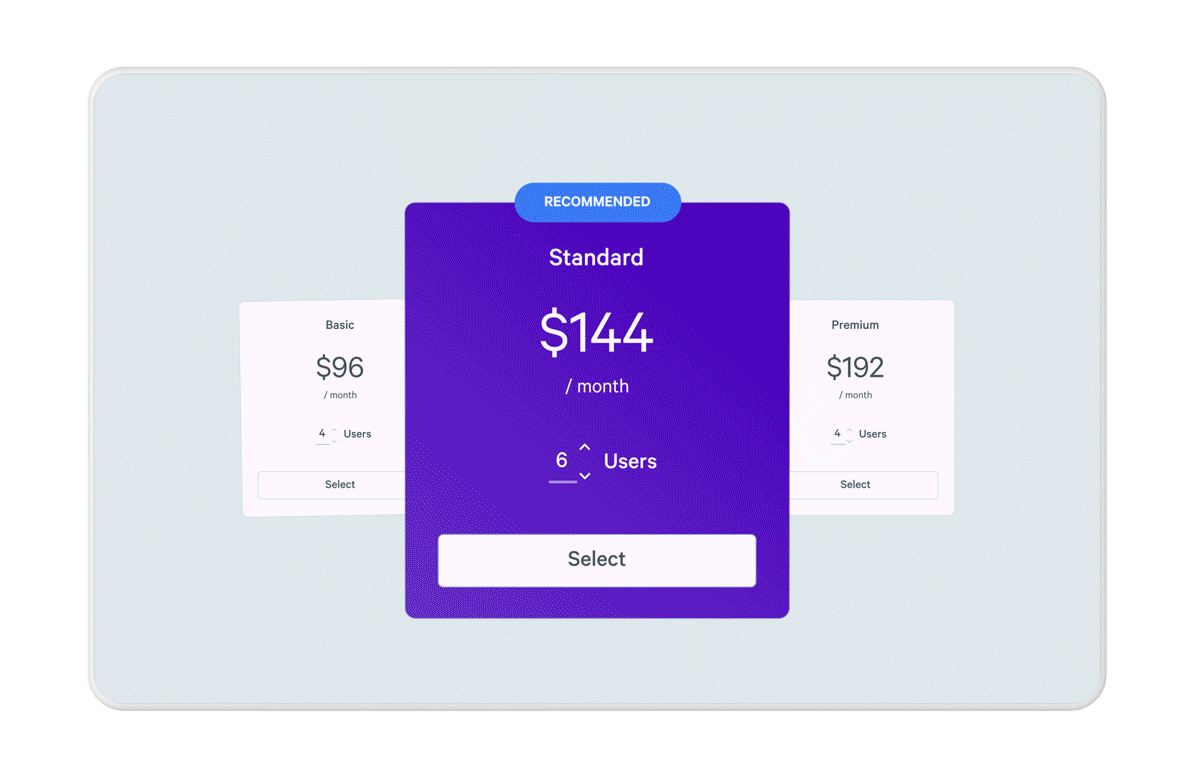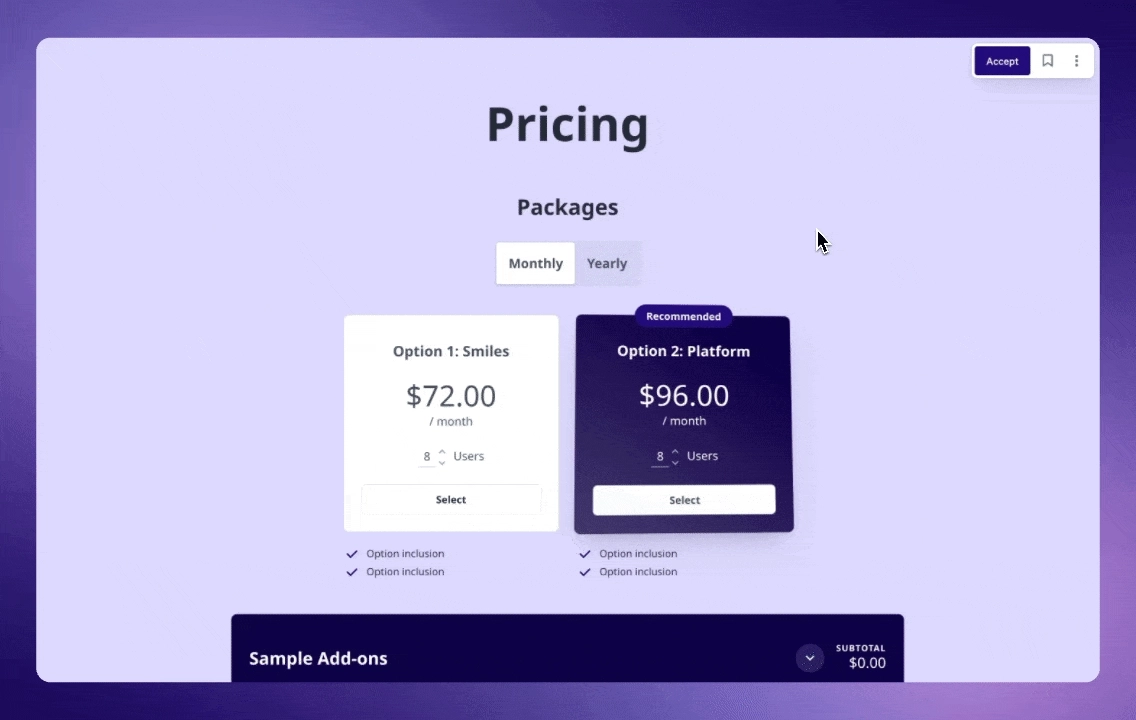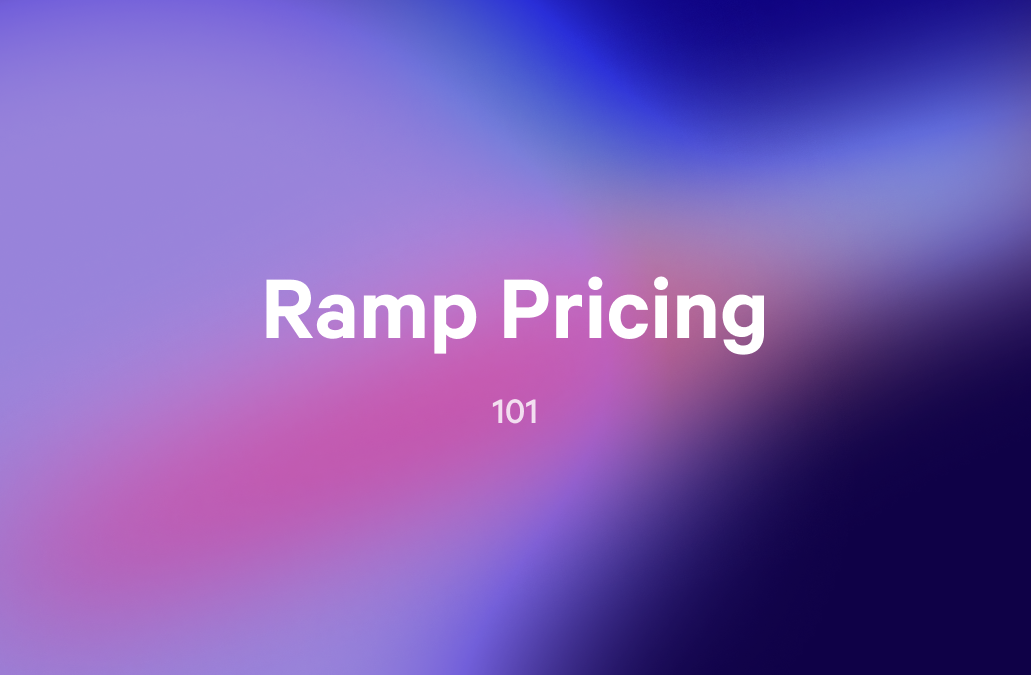Let’s face it: if your price is too low, you’re leaving money on the table. Too high, and customers vanish faster than your New Year’s gym motivation. But just when you think you've got pricing figured out, along comes the misunderstood middle child of the monetization family: bundle pricing.
Bundle pricing isn’t new. It’s been around since cavemen started trading firewood and mammoth steaks as a package deal. But in today’s hyper-competitive, SaaS-everywhere, value-packed world, bundle pricing is less about smoke signals and more about mindset, data, and yes, presentation.
In this article, we’ll break down bundle pricing like a middle manager breaking down why “synergy” is important. But we’ll actually make it useful.
Ready to bundle up? Let’s go.
Key takeaways:
- Bundle pricing boosts perceived value and conversions by leveraging buyer psychology like loss aversion and decision fatigue relief.
- There are multiple bundling strategies such as pure, mixed, tiered, and custom, that should be matched to your product, audience, and goals.
- Effective bundles are driven by customer needs, smart pricing logic, and clear, engaging presentation _ not just discounts.
- Tools like Qwilr help sales teams present and bundles dynamically, making it easier to close deals and showcase value.
What is bundle pricing?
Bundle pricing is when you group several products or services together and sell them at a combined price, usually lower than the sum of their individual prices. Sounds simple, right? And on paper, it is. You take Product A ($10), Product B ($15), and Product C ($20), bundle them into one attractive package, and sell it for $35 instead of $45.
Boom. Profit.
Except it’s never that simple. Bundle pricing sits at the intersection of perceived value, revenue strategy, customer psychology, and, let’s not forget, product-market fit. You’re not just selling more stuff; you’re orchestrating a value narrative.
And that’s why when done right, bundle pricing doesn’t just increase average order value (AOV). It boosts conversion rates, improves customer retention, and creates a delightful little upsell factory.
But when done wrong? You confuse your customers, reduce your margins, and end up writing sad Slack messages about why this month’s numbers are “soft.”
Why bundle pricing works: in the mind of a buyer
Bundle pricing isn't just a financial tactic. It’s a psychological power move. Here’s why it works (and makes your inner revenue nerd giddy):
1. Perceived value
Everyone loves a deal. When customers see a bundle, their brains go:
“Wow, I get all of this... for that price?”
Even if they don’t need all of it. Even if they only want one part. The perceived value is higher than the actual cost. That’s the magician's trick behind bundle pricing: it feels generous while remaining strategic.
2. Loss aversion
Customers don’t want to miss out. When you show what’s included in a bundle, even optional extras start to feel essential. “Sure, I don’t need 24/7 support… but it’s included in the bundle. I’d be stupid not to.”
(Note: they are not stupid. You are brilliant.)
3. Decision fatigue relief
Too many choices lead to paralysis. Bundles simplify the process. Instead of choosing between A, B, and C, your customer picks one bundle. Thank you, bundling, for reducing churn and existential dread.
The types of bundle pricing (and who should use them)
You’d think bundle pricing is one-size-fits-all. It's not. There are different strategies based on what you’re selling, who you're selling to, and how close you are to having a pricing meltdown.
Bundle pricing isn’t just a monolith. How aggressively do you want to scale revenue without sounding like a late-night infomercial? Let’s break it down into distinct models with more nuance, plus what they actually look like in the wild.
1. Pure bundling
Definition: Products are only available as a package: you cannot buy them individually.
Who uses it: Some legacy enterprise platforms, streaming service bundles (Disney+ + Hulu + ESPN+), or niche industries where the components only work together.
Why it works:
- Forces the adoption of complementary tools (especially when one is the hook and the others are stickier)
- Keeps pricing simple: one tier, one option, one price
- Great for onboarding customers quickly without overloading them with choices
Risks:
- Can frustrate customers who only want one part of the offering
- May lower perceived flexibility or personalization
- If your competitors offer more modular pricing, customers may jump ship
Example:
A cybersecurity platform that offers antivirus, firewall, and threat monitoring as one non-negotiable monthly bundle. You can’t just get the firewall. You get all or nothing.

2. Mixed bundling
Definition: Customers can buy individual products or get them in a discounted bundle. This is the most common and flexible bundle model.
Who uses it: SaaS platforms, service providers, ecommerce shops… basically everyone with half a marketing team.
Why it works:
- Increases average order value without reducing customer freedom
- Enables upselling by showcasing the value delta between bundle and standalone items
- Gives buyers a “smart shopper” feeling when they choose the bundle
Risks:
- Cannibalization: Some customers may downgrade from individual items to a cheaper bundle. (In case you’re not sure, cannibalization refers to a situation where a new product or offer eats into the sales of an existing product from the same company, instead of expanding the market or attracting new customers.)
- Requires careful pricing strategy to make the bundle feel like a deal, not a gimmick
Example:
- Adobe Creative Cloud: Buy Photoshop, Illustrator, or Premiere separately, or just get all apps in one bundle for less than the sum of the parts.
3. Leader (or captive) bundling
Definition: One “hero” product is bundled with secondary, supportive items. Think of this as bundling with intent: you're attaching accessories to a high-value core.
Who uses it: Hardware companies, consulting firms, agencies, app ecosystems
Why it works:
- Customers are already convinced by the flagship product; the add-ons sweeten the deal
- Increases perceived value and can introduce features customers wouldn’t normally consider
- Often used to “lock in” customers to a product ecosystem
Risks:
- Add-ons may be underused, reducing long-term perceived value
- Risk of giving away too much if pricing isn’t well-structured
Example:
- A project management SaaS bundles its core PM software with time tracking, client reporting, and onboarding templates.
4. Custom (build-your-own) bundling
Definition: Customers mix and match products to create their own bundle. Think Pizza Hut, but for software.
Who uses it: SaaS companies with modular tools, ecommerce platforms,and B2B service providers
Why it works:
- Puts customers in control - huge win for B2B buyers
- Enables hyper-personalization without requiring 1:1 sales calls
- Reduces objections (“I don’t need X” – cool, don’t select it)
Risks:
- Higher setup and UX complexity
- May cause decision paralysis if too many options are available
- Can require robust tech to price bundles dynamically
Example:
- A marketing automation platform where users can toggle email automation, SMS messaging, A/B testing, and AI-powered content creation. Pricing updates dynamically.
5. Tiered bundling (good-better-best)
Definition: Classic three-tier pricing: each tier bundles more features or value than the previous one. Often called Bronze/Silver/Gold or Starter/Pro/Enterprise.
Who uses it: Everyone from SaaS to car washes
Why it works:
- Gives buyers a clear upgrade path
- Uses the “decoy effect” i.e. the middle tier becomes the target (not too cheap, not too pricey)
- Great for segmentation
Risks:
- If tiers aren’t well-balanced, customers may default to the cheapest
- Too many tiers confuse people - three is the sweet spot
Example:
- A digital proposal software (like Qwilr 😉) offering:
- Starter: 5 proposals/month, basic analytics
- Professional: Unlimited proposals, analytics, CRM integration
- Enterprise: Everything + custom branding, SSO, and dedicated support

6. Add-on bundling
Definition: Base product sold separately, but you can tack on services/features for a fee. Not a bundle per se, but bundle-ish.
Who uses it: SaaS, ecommerce, travel booking sites, freelancers
Why it works:
- Allows price-sensitive customers to get in cheap
- Lets power users customize and upgrade without bloating the base offer
- Keeps your core product lean while monetizing power users
Risks:
- It can feel like “nickel-and-diming” if not positioned well
- Requires careful UX to avoid decision fatigue
Example:
A proposal platform offers core functionality at $20/mo but allows add-ons like white-label branding, document analytics, or eSignatures for an additional fee.

7. Cross-sell bundling
Definition: Bundle complementary, but separate, products from your catalog. This increases wallet share and engagement across your product lines.
Who uses it: E-commerce brands, software suites, consulting firms
Why it works:
- Increases lifetime value (LTV)
- Shows customers how your ecosystem fits together
- Turns occasional buyers into multi-product users
Risks:
- Requires strong brand trust
- Can dilute focus if bundled products feel irrelevant
Example:
- A web design agency bundles a new client website with a quarterly SEO audit and email marketing setup: each a separate service line, but sold together for efficiency and perceived savings.
Strategic tip:
You don’t need just one bundle strategy. The smartest companies use multiple models across customer segments.
For example:
- Use pure bundling for lower-tier freemium conversion
- Offer mixed bundles for mid-tier sales
- Give your enterprise team the power to create custom bundles (via Qwilr proposals) for high-touch deals
Read next: Behind the Curtain of Marketing Agency Pricing Models
How to price a bundle (without losing your shirt)
Bundle pricing isn’t about “discount until it hurts.” It’s about structuring value in a way that makes the bundle irresistible and profitable.
Here are a few bundle pricing tactics that actually work:
1. The anchor and contrast effect
Present the bundle next to individual pricing to highlight the discount. Or better yet, next to a premium bundle. This contrast makes the mid-tier bundle look like a steal.
2. The decoy effect
Offer three bundles: Basic, Premium, and Ultimate. The middle one should be your real target. The “Ultimate” is just there to make Premium look like a smart, balanced choice. Devious? Slightly. Effective? Hugely.
3. Use cost-based vs. value-based logic
Your bundle price should be based on perceived value, not just cost-plus math. If your product helps a company make $100k, pricing the bundle at $500 isn’t generous; it’s insane.
Here’s a top tip on how to make the most of this concept! Qwilr’s pricing pages make it easy to frame the value around ROI. Use embedded ROI calculators or dynamic pricing modules to reinforce just how much your customer is saving by spending more.

Real-world bundle pricing examples
Let’s look at how some of the big players do it (and occasionally, how they fumble).
1. Adobe Creative Cloud
Their bundle is the poster child for mixed bundling. Each app is available separately, but the “All Apps” plan gives you everything for a relative steal.
Why it works:
- High perceived value
- Psychological pain of missing out on future needs
- Clear monthly savings
2. Spotify + Hulu + Showtime
Ah, the media mega-bundle. Great for students, better for subscriber retention.
Why it works:
- Cross-category value
- Convenience trumps price comparisons
- Once you’re in, it’s hard to leave (classic bundling goal)
3. Enterprise SaaS bundles that shall not be named
These are often overstuffed, overpriced, and oversold. Ten features you’ll never use. Three onboarding calls you’ll skip. One shared Slack channel that haunts you at 3 a.m.
Why it doesn’t work:
- Poor targeting
- Lack of flexibility
- Poor presentation
Bundle pricing pages do not need to look like a tax form married a PDF and had a baby called "confusion." Long lists. No visuals. No clear sense of value. It’s not that the bundle is bad. It just looks... deeply unappealing.
Qwilr can fix this presentation problem, offering interactive pricing blocks and more:
Interactive pricing tables
Let buyers click, toggle, and choose what they want. No spreadsheets. No guesswork. Just clean, intuitive pricing and automated quotes straight from your CRM.
Embedded content
Want to add a 60-second explainer video or quick demo? Drop it right into the page. Let buyers see the value, not read a 500-word paragraph trying to describe it.
Modular sections
Break your bundles into digestible blocks: intro, features, benefits, pricing, testimonials. Skip the wall-of-text syndrome.
Mobile-optimized and responsive
Because no one should have to pinch-zoom a pricing table on their phone like it’s 2007.
Track engagement
Qwilr tells you who viewed your proposal, which sections they spent time on, and what they clicked, so you know what’s landing and what needs work.
Collect payments easily
With QwilrPay you can now easily collect and track payments within your proposal. Buyer experience is top-notch with a range of payment options.

Common bundle pricing mistakes (and how to avoid them)
1. Bundling for you, not the customer
The mistake: You build bundles around your priorities (inventory, MRR goals) instead of customer needs.
Why it fails: Irrelevant bundles confuse people and kill conversions.
Fix it: Use customer data to bundle what they actually want. Segment by persona or use case.
2. Mispricing the bundle
The mistake: You randomly discount, or don’t discount at all, and call it “value.”
Why it fails: Customers won’t buy if it feels overpriced or suspiciously cheap.
Fix it: Price each component, show savings clearly, and anchor with value before discounting.
3. Forcing every buyer into the same bundle
The mistake: No à la carte options. No flexibility. Just “take it or leave it.”
Why it fails: People want control. If they can’t pick, they’ll bounce.
Fix it: Offer tiered or build-your-own bundles.
4. Overstuffing the bundle
The mistake: You cram in every feature, call, and add-on to “add value.”
Why it fails: Customers get overwhelmed and ignore most of it. Usage drops. Churn follows.
Fix it: Start simple. Upsell extras instead of forcing them.
Hiding the value
The mistake: Your bundle’s value is buried in confusing pricing tables or jargon.
Why it fails: If buyers can’t see the deal quickly, they move on.
Fix it: Use clear comparisons, strike-throughs, and simple visuals.
Bundle pricing and sales teams: A match made in (spreadsheet) heaven
Salespeople love bundles until they have to explain them. Or worse, quote them.
With Qwilr, your sales team can send interactive proposals that adapt to bundle selections in real time. Want to show a video walkthrough of the Premium Bundle? Embed it. Need to highlight savings dynamically as they toggle options? Done. Want to track who opened what, when, and how long they lingered on the pricing page? Qwilr has your back.
Here’s how bundle pricing + Qwilr = sales joy:
| Problem | Qwilr Solution |
|---|---|
Complex bundle configurations | Interactive pricing tables & automated quotes |
Static PDFs | Web-based, mobile-friendly pages |
Manual follow-ups | Instant notifications when a proposal is viewed |
Misunderstood value | Embedded videos, charts, and calculators |
Your proposals should do more than sit in inboxes. They should sell. Bundle pricing is your strategy… and Qwilr is your weapon.
Bundle pricing in SaaS: Trends to watch
SaaS pricing is where bundle pricing gets spicy. Here’s what’s trending:
1. Modular pricing
Customers can build their own bundles by toggling features, user seats, and add-ons. Think Slack, Notion, and every SaaS with a pulse.
2. Usage-based bundles
Not just “what” the customer gets, but “how much.” Bundles now include usage tiers for APIs, data storage, or user activity.
3. Outcome-based bundles
You’re not just bundling features — you’re bundling outcomes. Think “Lead Gen Growth Kit” or “Customer Success Bundle” instead of “CRM + Email + Reports.”
Naming matters. Presentation matters more. (Remember what we said earlier?)
Bundle pricing is a tool, not a trap
Used wisely, bundle pricing can be one of the most powerful levers in your pricing strategy. But it requires more than slapping products together and yelling “value!” to your customers.
What do you need? Strategy. Psychology. Data. Flexibility. Presentation.
And if you’re thinking “that’s a lot,” you’re not wrong. That’s why Qwilr exists: to make all of this easier, smarter, and frankly, prettier. Sign up for a free trial and present like the savvy revenue-generating genius you are.
(And if you’re still sending bundles in PDFs? We need to talk.)
About the author

Dusty Martin|Revenue Operations Manager, Qwilr
Dusty is Qwilr's Revenue Operations Manager, working with a distributed sales team to drive revenue in the most efficient way possible.


